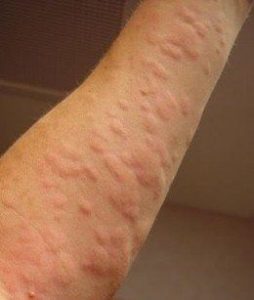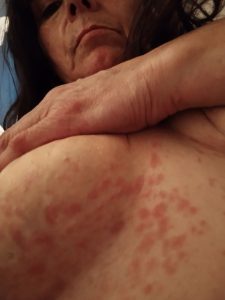some cases, chronic hives can be triggered by infections, stress, or even immune system disorders such as lupus or thyroid disease.
Other potential diagnoses that doctors considered included: Scabies – A highly contagious skin condition caused by mites burrowing under the skin, leading to relentless itching and rashes.
Scabies – A highly contagious skin condition caused by mites burrowing under the skin, leading to relentless itching and rashes. Heat Rash (Miliaria) – A common condition in hot weather, where blocked sweat glands cause red, itchy bumps.
Heat Rash (Miliaria) – A common condition in hot weather, where blocked sweat glands cause red, itchy bumps. Eczema (Atopic Dermatitis) – A long-term skin disorder causing inflammation, dryness, and severe itching.
Eczema (Atopic Dermatitis) – A long-term skin disorder causing inflammation, dryness, and severe itching. Skin Parasitic Infections – In rare cases, itching and bumps could be a sign of parasitic infestations such as bed bugs or fungal infections.
Skin Parasitic Infections – In rare cases, itching and bumps could be a sign of parasitic infestations such as bed bugs or fungal infections.

Treatment and Recovery
Once doctors identified the root cause of James’ symptoms, they created a treatment plan tailored to his condition. This included: Antihistamines – To block histamine production and reduce itching.
Antihistamines – To block histamine production and reduce itching. Corticosteroid Creams – To soothe inflammation and prevent further skin irritation.
Corticosteroid Creams – To soothe inflammation and prevent further skin irritation. Lifestyle Changes – Avoiding known triggers such as stress, processed foods, and harsh chemicals in detergents.
Lifestyle Changes – Avoiding known triggers such as stress, processed foods, and harsh chemicals in detergents. Moisturization and Proper Skincare – Keeping skin hydrated to reduce flare-ups.
Moisturization and Proper Skincare – Keeping skin hydrated to reduce flare-ups.
After a few weeks of treatment, James finally found relief. However, his experience was a wake-up call—never ignore persistent skin problems.

When to See a Doctor for Skin Issues
If you or someone you know experiences unexplained itching, persistent rashes, or unusual skin changes, consult a healthcare professional. It may be a simple allergy, but it could also be an early sign of a more serious medical condition.
 Early diagnosis and treatment can prevent complications and ensure a speedy recovery.
Early diagnosis and treatment can prevent complications and ensure a speedy recovery.
 Have you ever experienced a skin condition that turned out to be more than just an allergy? Share your thoughts below!
Have you ever experienced a skin condition that turned out to be more than just an allergy? Share your thoughts below!
Post Views: 352















